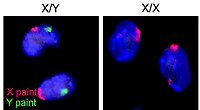
Back إخصاب داخلي Arabic Вътрешно оплождане Bulgarian Fecundació interna Catalan Indre befrugtning Danish Fertilización interna Spanish لقاح داخلی Persian Pembuahan internal ID 体内受精 Japanese 체내 수정 Korean Fertilizatio interna Latin
| Part of a series on |
| Sex |
|---|
 |
| Biological terms |
| Sexual reproduction |
| Sexuality |
| Sexual system |
Internal fertilization is the union of an egg and sperm cell during sexual reproduction inside the female body. Internal fertilization, unlike its counterpart, external fertilization, brings more control to the female with reproduction.[1] For internal fertilization to happen there needs to be a method for the male to introduce the sperm into the female's reproductive tract.
Most taxa that reproduce by internal fertilization are gonochoric.[2]: 124–125 Male mammals, reptiles, and certain other vertebrates transfer sperm into the female's vagina or cloaca through an intromittent organ during copulation.[3][4][5] In most birds, the cloacal kiss is used, the two animals pressing their cloacas together while transferring sperm.[6] Salamanders, spiders, some insects and some molluscs undertake internal fertilization by transferring a spermatophore, a bundle of sperm, from the male to the female. Following fertilization, the embryos are laid as eggs in oviparous organisms, or continue to develop inside the reproductive tract of the mother to be born later as live young in viviparous organisms.
- ^ Alonzo SH, Stiver KA, Marsh-Rollo SE (August 2016). "Ovarian fluid allows directional cryptic female choice despite external fertilization". Nature Communications. 7 (1): 12452. Bibcode:2016NatCo...712452A. doi:10.1038/ncomms12452. PMC 4990696. PMID 27529581.
- ^ Cite error: The named reference
:2was invoked but never defined (see the help page). - ^ Naguib, Marc (2020-04-19). Advances in the Study of Behavior. Academic Press. ISBN 978-0-12-820726-0.
- ^ Hyman LH (15 September 1992). Hyman's Comparative Vertebrate Anatomy. University of Chicago Press. ISBN 978-0-226-87013-7.
- ^ Cite error: The named reference
Austinwas invoked but never defined (see the help page). - ^ Cite error: The named reference
VBwas invoked but never defined (see the help page).